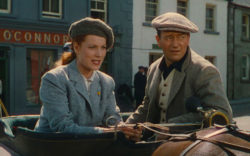Brooklyn-based filmmaker Jorge Torres-Torres’ Phantasm Revision is a bold gambit that edits all five parts of Don Coscarelli’s horror series Phantasm into one film, boiling more than 400 minutes down to 89. He returns to his native Athens Friday for the film’s VHS release party at Flicker, complete with a post-screening Q&A and sets from bands Lipperscapes and Rat Babies. The evening will also serve as the debut of Dain Marx’s Phantasm action figures.
Gear up for the event by watching Clive Barker’s Hellraiser, another horror story about other-dimensional beings menacing suburbanites that makes a kinky prelude to the party.
Go Out and Watch
PHANTASM REVISION (2016) Phantasm Revision is a great primer for these films about a band of friends fighting the violent Tall Man, his dwarf minions and his Sentinel Spheres—sentient metal orbs covered with murder weapons. This CliffsNotes version of the series effectively condenses footage captured over 37 years. Phantasm was released in 1979, and series-ender Phantasm: Ravager dropped last year. This edit represents the achievement of a long-held goal of the filmmaker.
“For many years, I wanted to re-edit a franchise into a single, visceral experience, and it wasn’t until I saw all the Phantasm films that I realized that it could be done,” Torres-Torres explains. “I’ve always wanted to see a film where the actors actually age, but not just age a couple years. I want to see a real child become an adult within the film’s 89-minute length.”
By collapsing time on a series where the same actors, more or less, appeared in each feature (the series’ protagonist, Michael, was played by actor James LeGros in Phantasm II), Torres-Torres creates a rarity that was last experienced in Richard Linklater’s Boyhood. The audience sees time reflected in every gray hair, weight gain and wrinkle the actors sport. In making the series a document of time’s passing, Phantasm becomes real in a way that transcends every shitty special effect.
The condensing falters, though, when it comes to cohesiveness. Torres-Torres transitions between footage from movies largely through dream-sequence and flashback-framing methods. These incidents are a great way to unsettle and disorient viewers—the mission statement of any good horror movie—but having too many of them in a row gives the audience the feeling of a narrative free-fall.
Character motivations are the biggest casualty of this effect, with characters seemingly performing any action just to move to the next set-piece. The Tall Man pursues Michael over five films to induct him into his evil army, but his reasons for this pursuit are never really revealed. Whether such an explanation exists in the footage that did not make the cut is unclear.
Despite these issues, Phantasm Revision succeeds as a great delivery system for gore, a lovingly made visual mixtape to be shared on a big screen where plenty of booze can be consumed. At the very least, it encourages one to see the full films that inspired Torres-Torres’ fervent devotion.
Stay Home and Watch
HELLRAISER (1987) British horror author Clive Barker shepherded his own material to the screen for the first time as the director of Hellraiser. The action revolves around a metal puzzle box that draws individuals into the dimension of the leather-clad Cenobites, self-described “explorers in the further regions of experiences.” These S&M demons hunt former victim Frank Cotton (Sean Chapman), who conspires with former lover Julia (Clare Higgins)—currently married to his brother Larry (Andrew Robinson)—to bring him the human sacrifices he needs to rebuild his body.
Barker’s work never shies away from characters whose sexual practices lie off the beaten path, and Hellraiser is no exception. At the start of the film, Frank actually pursues the Cenobites so he can experience “pain and pleasure, indivisible.” Julia’s betrayal of her husband for Frank creates the film’s strongest visual metaphors linking sex and violence. As the story flashes back to the first time Frank and Julia had sex, footage of her husband Larry moving a mattress in the present—grunting and thrusting—is intercut. The cuts quicken as Larry gashes his hand on an errant nail at the moment his wife climaxes. When a drop hits the floor, Larry’s blood becomes the catalyst for his brother’s regeneration, enabling the continuation of his masochism.
While other horror films of the 1980s showed violence as a punishment for sex, Barker portrays the two as symbiotic, an MO that follows the Cenobites across nine films, even after Barker’s involvement ended with the fourth.
Like what you just read? Support Flagpole by making a donation today. Every dollar you give helps fund our ongoing mission to provide Athens with quality, independent journalism.










